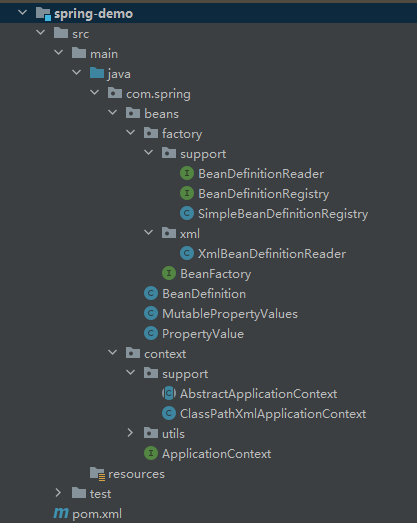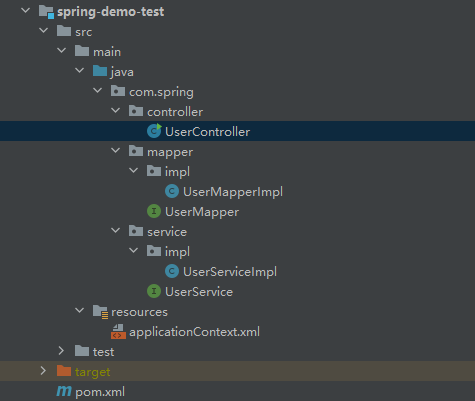applicationContext.xml
<?xml version="1.0" encoding="UTF-8"?>
<beans>
<bean id="userMapper" class="com.spring.mapper.impl.UserMapperImpl">
<property name="name" value="孙笑川"/>
<property name="password" value="123456"/>
</bean>
<bean id="userService" class="com.spring.service.impl.UserServiceImpl">
<property name="userMapper" ref="userMapper"/>
</bean>
</beans>1. pojo
(1)PropertyValue类
用于封装bean的属性
public class PropertyValue {
/**
* name
*/
private String name;
/**
* ref
*/
private String ref;
/**
* value:给基本数据类型及String类型赋的值
*/
private String value;
public PropertyValue() {
}
public PropertyValue(String name, String ref, String value) {
this.name = name;
this.ref = ref;
this.value = value;
}
public String getName() {
return name;
}
public void setName(String name) {
this.name = name;
}
public String getRef() {
return ref;
}
public void setRef(String ref) {
this.ref = ref;
}
public String getValue() {
return value;
}
public void setValue(String value) {
this.value = value;
}
}(2)MutablePropertyValues类
一个bean标签可以有多个 property 子标签,该类用于存储并管理多个 Propertyvalue 对象
public class MutablePropertyValues implements Iterable<PropertyValue> {
private final List<PropertyValue> propertyValueList;
public MutablePropertyValues() {
this.propertyValueList = new ArrayList<>();
}
public MutablePropertyValues(List<PropertyValue> propertyValueList) {
if (propertyValueList == null) {
this.propertyValueList = new ArrayList<>();
} else {
this.propertyValueList = propertyValueList;
}
}
/**
* 获取PropertyValue数组
*
* @return
*/
public PropertyValue[] getPropertyValues() {
return propertyValueList.toArray(new PropertyValue[0]);
}
/**
* 根据名称获取PropertyValue对象
*
* @param propertyName
* @return
*/
public PropertyValue getPropertyValueByName(String propertyName) {
for (PropertyValue propertyValue : propertyValueList) {
if (propertyValue.getName().equals(propertyValue)) {
return propertyValue;
}
}
return null;
}
/**
* 判断集合是否为空
*
* @return
*/
public boolean isEmpty() {
return propertyValueList.isEmpty();
}
/**
* 添加
*
* @param propertyValue
* @return
*/
public MutablePropertyValues addPropertyValue(PropertyValue propertyValue) {
for (int i = 0; i < propertyValueList.size(); i++) {
PropertyValue currentPropertyValue = this.propertyValueList.get(i);
if (currentPropertyValue.getName().equals(propertyValue.getName())) {
propertyValueList.set(i, new PropertyValue(propertyValue.getName(), propertyValue.getRef(), propertyValue.getValue()));
return this;
}
}
this.propertyValueList.add(propertyValue);
return this;
}
/**
* 判断是否包含指定名称的PropertyValue对象
*
* @param propertyName
* @return
*/
public boolean contains(String propertyName) {
return this.getPropertyValueByName(propertyName) != null;
}
/**
* 获取迭代器对象
*
* @return
*/
@Override
public Iterator<PropertyValue> iterator() {
return propertyValueList.listIterator();
}
}
(3)BeanDefinition
BeanDefinition 用来封装 bean 的信息,主要包含id(bean对象的名称)、class(需交由 spring 管理的类的全路径类名)、子标签 property 数据
public class BeanDefinition {
private String id;
private String className;
private MutablePropertyValues propertyValues;
public BeanDefinition() {
propertyValues = new MutablePropertyValues();
}
public String getId() {
return id;
}
public void setId(String id) {
this.id = id;
}
public String getClassName() {
return className;
}
public void setClassName(String className) {
this.className = className;
}
public MutablePropertyValues getPropertyValues() {
return propertyValues;
}
public void setPropertyValues(MutablePropertyValues propertyValues) {
this.propertyValues = propertyValues;
}
}2. 注册表
(1)BeanDefinitionRegistry接口
- 注册
BeanDefinition对象到注册表中 - 从注册表中删除指定名称的对象
- 根据名称获取指定对象
- 根据名称判断是否包含指定对象
- 获取已注册
bean的个数 - 获取已注册
bean的名称数组
public interface BeanDefinitionRegistry {
/**
* 注册BeanDefinition对象到注册表中
*
* @param beanName
* @param beanDefinition
*/
void registerBeanDefinition(String beanName, BeanDefinition beanDefinition);
/**
* 从注册表中删除指定名称的对象
*
* @param beanName
*/
void removeBeanDefinition(String beanName);
/**
* 根据名称获取指定对象
*
* @param beanName
* @return
*/
BeanDefinition getBeanDefinition(String beanName);
/**
* 根据名称判断是否包含指定对象
*
* @param beanName
* @return
*/
boolean containsBeanDefinition(String beanName);
/**
* 获取已注册bean的个数
*
* @return
*/
int getBeanDefinitionCount();
/**
* 获取已注册bean的名称数组
*
* @return
*/
String[] getBeanDefinitionNames();
}(2)SimpleBeanDefinitionRegistry类
该类实现了 BeanDefinitionRegistry 接口,并定义Map集合作为注册表容器
public class SimpleBeanDefinitionRegistry implements BeanDefinitionRegistry {
/**
* BeanDefinition存储容器
*/
private Map<String, BeanDefinition> beanDefinitionMap = new HashMap<>();
@Override
public void registerBeanDefinition(String beanName, BeanDefinition beanDefinition) {
beanDefinitionMap.put(beanName, beanDefinition);
}
@Override
public void removeBeanDefinition(String beanName) {
beanDefinitionMap.remove(beanName);
}
@Override
public BeanDefinition getBeanDefinition(String beanName) {
return beanDefinitionMap.get(beanName);
}
@Override
public boolean containsBeanDefinition(String beanName) {
return beanDefinitionMap.containsKey(beanName);
}
@Override
public int getBeanDefinitionCount() {
return beanDefinitionMap.size();
}
@Override
public String[] getBeanDefinitionNames() {
return beanDefinitionMap.keySet().toArray(new String[0]);
}
}3. 解析器
(1)BeanDefinitionReader接口
用于解析配置文件并在注册表中注册bean的信息:
- 获取注册表功能,让外界可以通过此对象获取注册表对象
- 加载配置文件,并注册bean数据
public interface BeanDefinitionReader {
/**
* 获取注册表对象
*
* @return
*/
BeanDefinitionRegistry getRegistry();
/**
* 加载配置文件并在注册表中注册
*
* @param configLocation
*/
void loadBeanDefinitions(String configLocation) throws DocumentException;
}(2)XmlBeanDefinitionReader类
用于解析xml配置文件,该类实现了 BeanDefinitionReader 接口
public class XmlBeanDefinitionReader implements BeanDefinitionReader {
/**
* 声明注册表对象
*/
private BeanDefinitionRegistry registry;
public XmlBeanDefinitionReader() {
registry = new SimpleBeanDefinitionRegistry();
}
@Override
public BeanDefinitionRegistry getRegistry() {
return registry;
}
@Override
public void loadBeanDefinitions(String configLocation) throws DocumentException {
SAXReader reader = new SAXReader();
//获取类路径下的配置文件
InputStream is = XmlBeanDefinitionReader.class.getClassLoader().getResourceAsStream(configLocation);
Document document = reader.read(is);
//根标签
Element rootElement = document.getRootElement();
//根标签下的bean标签对象
List<Element> beanElementList = rootElement.elements();
for (Element beanElement : beanElementList) {
//id
String id = beanElement.attributeValue("id");
//class
String className = beanElement.attributeValue("class");
MutablePropertyValues propertyValues = new MutablePropertyValues();
//property
List<Element> propertyList = beanElement.elements("property");
for (Element propertyElement : propertyList) {
String name = propertyElement.attributeValue("name");
String ref = propertyElement.attributeValue("ref");
String value = propertyElement.attributeValue("value");
propertyValues.addPropertyValue(new PropertyValue(name, ref, value));
}
//封装
BeanDefinition beanDefinition = new BeanDefinition();
beanDefinition.setId(id);
beanDefinition.setClassName(className);
beanDefinition.setPropertyValues(propertyValues);
//将beanDefinition注册到注册表中
registry.registerBeanDefinition(id, beanDefinition);
}
}
}4. IOC容器
(1)BeanFactory接口
在该接口中定义IOC容器的统一规范(即获取 bean 对象)
public interface BeanFactory {
/**
* 根据名称获取bean
*
* @param name
* @return
*/
Object getBean(String name) throws Exception;
/**
* 根据名称、class类获取bean
*
* @param name
* @param clazz
* @param <T>
* @return
*/
<T> T getBean(String name, Class<? extends T> clazz) throws Exception;
}(2)ApplicationContext接口
该接口的所有子实现类对 bean 对象的创建都是非延时的,所以在该接口中定义 refresh() 方法:
- 加载配置文件
- 根据注册表中的
BeanDefinition对象封装的数据进行bean对象的创建
public interface ApplicationContext extends BeanFactory {
/**
* 加载配置文件并创建对象
*
* @throws Exception
*/
void refresh() throws Exception;
}(3)AbstractApplicationContext类
- 作为
ApplicationContext接口的子类,该类也是非延时加载,所以在该类中定义Map集合作为bean对象的存储容器 - 声明
BeanDefinitionReader类型的变量,进行xml配置文件解析;BeanDefinitionReader类型的对象的创建交由子类实现(因为只有子类明确创建BeanDefinitionReader哪个子实现类对象)
public abstract class AbstractApplicationContext implements ApplicationContext {
/**
* 声明解析器
*/
protected BeanDefinitionReader beanDefinitionReader;
/**
* 存储bean的容器
*/
protected Map<String, Object> singleObjects = new HashMap<>();
/**
* 配置文件路径
*/
protected String configLocation;
@Override
public void refresh() throws Exception {
//加载BeanDefinition
beanDefinitionReader.loadBeanDefinitions(configLocation);
//初始化bean
this.finishBeanInitialization();
}
/**
* 初始化bean
*/
private void finishBeanInitialization() throws Exception {
//获取注册表对象
BeanDefinitionRegistry registry = beanDefinitionReader.getRegistry();
//获取BeanDefinition
String[] beanNames = registry.getBeanDefinitionNames();
for (String beanName : beanNames) {
//执行初始化
getBean(beanName);
}
}
}注:finishBeanInitialization() 方法中的 getBean() 使用了模板方法
(4)ClassPathXmlApplicationContext类
该类主要功能是加载类路径下的配置文件,并创建 bean 对象:
- 在构造方法中,创建
BeanDefinitionReader对象 - 在构造方法中,调用
refresh()方法,用于加载配置文件、创建bean对象并存储到容器中 - 重写父接口中的
getBean()方法,并实现依赖注入
public class ClassPathXmlApplicationContext extends AbstractApplicationContext {
public ClassPathXmlApplicationContext(String configLocation) {
this.configLocation = configLocation;
//构建解析器
beanDefinitionReader = new XmlBeanDefinitionReader();
try {
this.refresh();
} catch (Exception e) {
}
}
@Override
public Object getBean(String name) throws Exception {
//判断对象容器中是否包含指定名称的容器对象,如果有则直接返回,反之进行创建
Object obj = singleObjects.get(name);
if (obj != null) {
return obj;
}
//获取BeanDefinition
BeanDefinitionRegistry registry = beanDefinitionReader.getRegistry();
BeanDefinition beanDefinition = registry.getBeanDefinition(name);
//根据bean标签数据中的类名反射创建对象
Class<?> clazz = Class.forName(beanDefinition.getClassName());
Object beanObj = clazz.newInstance();
//执行依赖注入
for (PropertyValue propertyValue : beanDefinition.getPropertyValues()) {
//name
String propertyName = propertyValue.getName();
//value
String value = propertyValue.getValue();
//ref
String ref = propertyValue.getRef();
if (ref != null && !"".equals(ref)) {
//获取依赖的bean对象
Object bean = getBean(ref);
//拼接方法名
String methodName = StringUtils.getSetMethodNameByFieldName(propertyName);
Method[] methods = clazz.getMethods();
for (Method method : methods) {
if (method.getName().equals(methodName)) {
method.invoke(beanObj, bean);
}
}
}
if (value != null && !"".equals(value)) {
String methodName = StringUtils.getSetMethodNameByFieldName(propertyName);
Method method = clazz.getMethod(methodName, String.class);
method.invoke(beanObj, value);
}
}
//在返回之前将该对象存储到bean容器中
singleObjects.put(name, beanObj);
return beanObj;
}
@Override
public <T> T getBean(String name, Class<? extends T> clazz) throws Exception {
Object bean = getBean(name);
if (bean == null) {
return null;
}
return clazz.cast(bean);
}
}5. 补充
pom.xml
<!-- dom4j -->
<dependency>
<groupId>dom4j</groupId>
<artifactId>dom4j</artifactId>
<version>1.6.1</version>
</dependency>项目结构:



评论 (0)